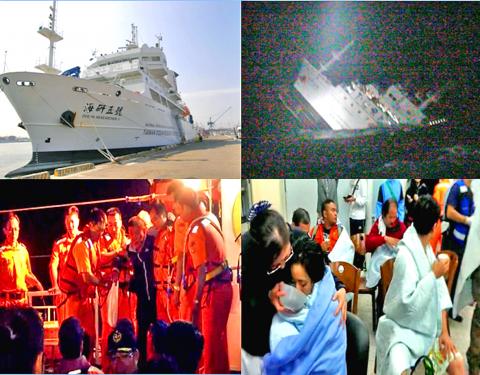The nation’s ability to conduct marine science, detect new energy sources and measure environmental change has suffered a major blow after a maritime research vessel sank on Friday, leaving two dead.
The Ocean Researcher V sank in stormy waters around 8:11pm, less than three hours after it first issued a distress call, said Chi Wen-jong (祁文中), director-general of the Maritime and Port Bureau.
The NT$1.46 billion (US$47.98 million), 2,700 tonne Ocean Researcher V is the largest research ship Taiwan owns, known for its state-of-the-art equipment and ability to operate in bad weather.

Photo montage: CNA
The ship had a remotely operated underwater vehicle that could descend to depths of 3,000m to search for the existence of fossil fuels such as natural gas and methane clathrate, experts said.
National Cheng Kung University marine technology professor Kao Chia-chuen (高家俊) said the ship was the most advanced maritime research vessel Taiwan had, and was mainly used for reef exploration.
Kao, who supervised the construction of the vessel, said findings by the ship could have contributed to Taiwan’s biofuel and hydrology studies, which were of great value to national security.
The ship collected and ignited high-density methane off southwest Taiwan last year, paving the way for the country’s energy exploration.
The ship was also able to analyze levels of marine pollutants and identify plate movements to assist in the prediction of earthquakes or tsunamis, experts said.
Besides the loss of hardware, the death of Hsu Shih-chieh (許世傑), a research fellow at the Academia Sinica, was also seen as a great loss to the field of marine science.
Hsu, 47, had spent the past decade studying marine particulate matter in the East China Sea and the South China Sea and was one of the top five experts in the field in Taiwan, said Liu Shaw-cheng (劉紹臣), director of the Research Center for Environmental Changes at Academia Sinica.
Another member of the crew, Lin Y-chun (林怡君), 30, passed away. According to her direct superior, the ship’s investigation division chief Yang Yi (楊益), Lin was very passionate about maritime affairs.
At a press conference yesterday, Minister of Science and Technology Simon Chang (張善政) stressed the importance of having a research vessel of the caliber of the Ocean Researcher V to the nation and said the ministry and related agencies would hold discussions about whether to repair it or build another vessel.
Chang said the loss of the ship would affect a total of 13 projects originally scheduled until August next year.
Additional reporting by Liu Yu-ching and Tsai Ying

Taiwan is to commence mass production of the Tien Kung (天弓, “Sky Bow”) III, IV and V missiles by the second quarter of this year if the legislature approves the government’s NT$1.25 trillion (US$39.78 billion) special defense budget, an official said yesterday. Commenting on condition of anonymity, a defense official with knowledge of the matter said that the advanced systems are expected to provide crucial capabilities against ballistic and cruise missiles for the proposed “T-Dome,” an advanced, multi-layered air defense network. The Tien Kung III is an air defense missile with a maximum interception altitude of 35km. The Tien Kung IV and V

The disruption of 941 flights in and out of Taiwan due to China’s large-scale military exercises was no accident, but rather the result of a “quasi-blockade” used to simulate creating the air and sea routes needed for an amphibious landing, a military expert said. The disruptions occurred on Tuesday and lasted about 10 hours as China conducted live-fire drills in the Taiwan Strait. The Civil Aviation Administration (CAA) said the exercises affected 857 international flights and 84 domestic flights, affecting more than 100,000 travelers. Su Tzu-yun (蘇紫雲), a research fellow at the government-sponsored Institute for National Defense and Security Research, said the air

Taiwan lacks effective and cost-efficient armaments to intercept rockets, making the planned “T-Dome” interception system necessary, two experts said on Tuesday. The concerns were raised after China’s military fired two waves of rockets during live-fire drills around Taiwan on Tuesday, part of two-day exercises code-named “Justice Mission 2025.” The first wave involved 17 rockets launched at 9am from Pingtan in China’s Fujian Province, according to Lieutenant General Hsieh Jih-sheng (謝日升) of the Office of the Deputy Chief of the General Staff for Intelligence at the Ministry of National Defense. Those rockets landed 70 nautical miles (129.6km) northeast of Keelung without flying over Taiwan,

A strong continental cold air mass is to bring pollutants to Taiwan from tomorrow, the Ministry of Environment said today, as it issued an “orange” air quality alert for most of the country. All of Taiwan except for Hualien and Taitung counties is to be under an “orange” air quality alert tomorrow, indicating air quality that is unhealthy for sensitive groups. In China, areas from Shandong to Shanghai have been enveloped in haze since Saturday, the ministry said in a news release. Yesterday, hourly concentrations of PM2.5 in these areas ranged from 65 to 160 micrograms per cubic meter (mg/m³), and pollutants were